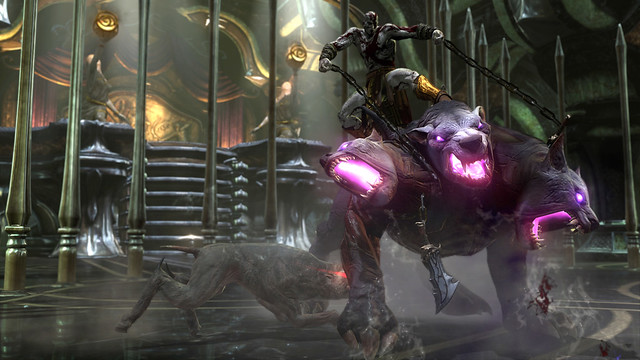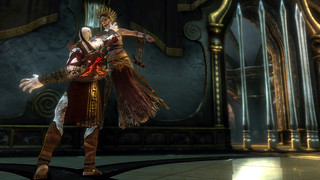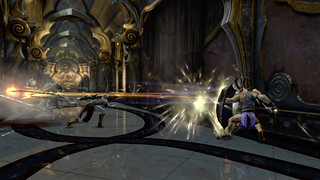
With God of War: Ascension’s launch just a few days away now, we sat down with the game’s Lead Combat Designer Jason McDonald and Lead Game Designer Mark Simon to find out how they’ve kept the formula fresh six games into the series, and what challenges the addition of multiplayer presented to the team.
We’ll have more insight from Game Director Todd Papy next week before Santa Monica’s lean, mean new actioner hits the shelves on March 12th. In the meantime, over to Mark and Jason…
Mark Simon: It’s kinda nice actually. At the end of God of War 3 Kratos is completely rage-filled. His sole-focus has been figured out. With Ascension, we can go back to a different time period before he was this character. He has a wider range and you can explain things about him that you didn’t know before. You get to find out what turned him into the guy that he is – what makes him snap, and why is it that breaking a bond with a god like Ares does this.
PSB: If I was to plot Kratos’ anger on a graph, I’d say he starts at ‘seriously ticked off’ for God of War 1 and climbs to ‘ball of latent fury’ for God of War 3. But from what I’ve played of Ascension, he starts this prequel with a serious rage on. What gives?
MS: Sure, he does! But that’s due to the way the story is told. It’s like Slumdog Millionaire, or something like that. He’s not at the beginning of the story when you start the game. It’s told in a non-linear fashion. It builds up to why he is in the prison – why he was taken there by The Furies.
PSB: Do you ever worry that you’re going to run out of Greek gods for Kratos to beat up?
“That’s the great thing about our studio – ideas come from everywhere.”
MS: Every game is a challenge, but the Greek mythos is so wide and varied. We could never do every myth that it has for us. We don’t find it limiting; it’s more exciting to explore more areas of it – new gods, new titans, new locales.
Take the Furies. They’re primordial. They’re from before the gods – they’re more powerful than the gods. Some of their abilities are just ridiculous – so powerful. They make really great nemeses for Kratos.
PSB: Do you have an in-house expert who spends all their time going through Homer looking for new myths and characters?
MS: The cool thing about the studio is that some ideas come from the director, and then a lot of it comes from the rest of the team. Someone comes in and says ‘Y’know this would be really cool!’ Suddenly you’re in a brainstorming session, and before you know it you’re building it into the game. That’s the great thing about our studio – ideas come from everywhere.
Jason McDonald: But if you look at the typical desk in the office you’ll see Greek mythology books, random Greek materials – we do often reference that so we have to have those around.
MS: And the movies! Immortals, Jason and the Argonauts – all of them. We can’t get enough!
PSB: There are no office fact-finding outings to Greece then?
JM: No, but you should recommend that!
MS: Santorini, maybe. There’s got to be some myths around that island, right?
PSB: Every God of War game has had a different director. How hard is it to maintain a consistent feel in every game?
JM: Even when the director changes, the core of the team remain the same. There’s a number of people who’ve been there for every title. Each director, when they assume that role, was really skilled to begin with, so it’s not like ‘Oh my god, what do I need to do?’ They know exactly what they need to do. Every director puts their spin on it. Like [Ascension director] Todd Papy was a designer, so with this game he kept a close eye on mechanics.
MS: I think that after a project this size and scope, it’s not unhealthy thing to go ‘You know what? The director is going to move onto another thing if he wants to’. We’re a team full of leads. So if one director decides he doesn’t want to do it on the next project, there are a lot of people who can help out.
PSB: The series is known for its visceral violence and I’ve already seen some brutal kills in Ascension. Was there ever a moment during development where you said ‘Okay, we went too far with that one…’?
MS: It’s got to feel impactful. If you swing a club and hit someone it’s got to feel like you’ve just hit them with a club. If it doesn’t, it feels gamey. We don’t want that gamey feeling – we want it to feel like you’re actually impacting someone’s head. It makes that sound, it feels like that – you kind of cringe thinking about it, but that’s what melee combat should feel like.
PSB: Which of the additions that you’ve made to the God of War formula this time around are you most happy with?
JM: The Rage system turned out really well. Everyone uses it differently and it’s nice to see that come together. The multiplayer though – seeing all that come together and people having fun – that’s an experience that is very unique to this game and I’m very proud we were able to accomplish it.
PSB: How did the decision to add multiplayer come about?
JM: I don’t remember anyone saying ‘it’s multiplayer time, let’s do it!’ It was more that we were curious about it. We hadn’t tried multiplayer before so we were asking ourselves ‘can it be done? Is there fun to be had?’
So we tried out a few tests using Kratos, as he was already built. What we found was that people would sit down with two Kratoses and have a lot of fun. They’d sit there for hours. It was un-tuned and very rough, but when we saw people enjoying it we thought it had merit. After that it was all about putting the God of War spin on it – making sure the scale reaches what we expect, and not just eight players bundled into a room fighting each other. We had to design modes and rules to make sure it wasn’t repetitive.
“We found that players really wanted to keep the action going as long as they could.”
PSB: How difficult was it to keep the combat balanced?
MS: You always start with something very simple – people fighting one another. Then you start adding new things and you watch the balance go out the window. Then you try desperately to get it back again before introducing another new thing. That’s how we iterate. We didn’t start with everything all at once.
PSB: How useful was the beta? Did players’ behavior take you by surprise?
MS: I learned a lot just looking at the data that comes in. I’d be like, ‘Woah, I can’t believe this guy opened 17 chests’ or ‘this guy actually killed three guys at once?!’
And the thing that I was surprised by was some of the stuff that I thought would be cool. Like, I thought it would be cool when the god throws the spear down in the middle of a match – everybody would get the same cinematic and we would have this big spectacle in the middle of a match.
I thought that would be cool. And it was cool… the first time. But it wasn’t cool the second time or the third time. We found that players really wanted to keep the action going as long as they could. And when the match was over they generally wanted to get right back to it again. So we took the camera cut out so as not to stop the action. The beta was really helpful for that kind of feedback.
PSB: Finally, I’ve got ask for your take on the PlayStation 4 announcement last month. What do you make of the new system?
JM: Very excited! We don’t get hardware leaps like this that often, so to have one coming up is very exciting. The social stuff in particular. The power is going to be awesome and we’ll have amazing artists and engineers who will be able to draw so much out of it – but the social stuff is great. It’s something gaming is moving towards so the more features that support people playing together, the better.














Comments are closed.
60 Comments
Loading More Comments